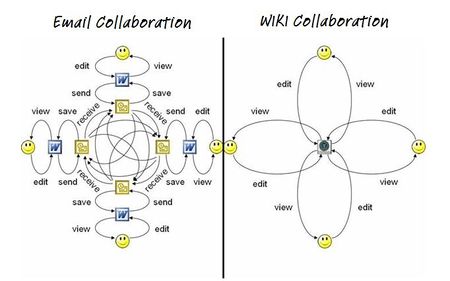|
|
| Line 8: |
Line 8: |
| | = How to Use a Project Wiki<br/> = | | = How to Use a Project Wiki<br/> = |
| | | | |
| − | Project managers can utilize this tool to transform the project office into a live and ubiquitous environment. <br/> | + | Project managers can utilize this tool to transform the project office into a live and ubiquitous environment.<br/> |
| | | | |
| | <u>A project wiki can facilitate the following tasks:</u><br/> | | <u>A project wiki can facilitate the following tasks:</u><br/> |
| Line 17: |
Line 17: |
| | *Calendars | | *Calendars |
| | *Project photo albums<br/> | | *Project photo albums<br/> |
| − | *To-Do lists <br/> | + | *To-Do lists<br/> |
| | *Establish a project office intranet<br/> | | *Establish a project office intranet<br/> |
| | | | |
| Line 26: |
Line 26: |
| | <br/><u>The table shows a comparison between traditional PM emphasis and the one offered by the wiki collaborative environment:</u><br/> | | <br/><u>The table shows a comparison between traditional PM emphasis and the one offered by the wiki collaborative environment:</u><br/> |
| | | | |
| − | {| border="1" style="width: 100%" | + | {| border="0" style="width: 100%" |
| | |- | | |- |
| | | style="background-color: rgb(204, 204, 204)" | Traditional PM Emphasis<br/> | | | style="background-color: rgb(204, 204, 204)" | Traditional PM Emphasis<br/> |
| Line 67: |
Line 67: |
| | <br/> | | <br/> |
| | | | |
| − | We should stop viewing projects as merely an opportunity for management authority but rather model them and interact with them as empowered teams in a live and realistic view. | + | We should stop viewing projects as merely an opportunity for management authority but rather model them and interact with them as empowered teams in a live and realistic view. |
| | | | |
| | <u>The proposed transformation is shown in the following figures:</u><br/> | | <u>The proposed transformation is shown in the following figures:</u><br/> |
| | | | |
| − | [[File:Authoritative Model - Traditional Team.JPG|none|315px|Authoritative Model - Traditional Team]][[File:Collaborative Model - Empowered Team.JPG|none|334px|Collaborative Model - Empowered Team|alt=Image:Project_wiki_2.gif]]<br/> | + | {| cellspacing="1" cellpadding="5" border="1" style="width: 100%" |
| | + | |- |
| | + | | [[File:Authoritative Model - Traditional Team.JPG|center|299px|Authoritative Model - Traditional Team|alt=Authoritative Model - Traditional Team]] |
| | + | | [[File:Collaborative Model - Empowered Team.JPG|center|359px|Collaborative Model - Empowered Team|alt=Image:Project_wiki_2.gif]] |
| | + | |} |
| | | | |
| | + | <br/> |
| | | | |
| | + | <br/> |
| | | | |
| | Source: [http://www.allpm.com/modules.php?op=modload&name=News&file=article&sid=1606&mode=thread&order=0&thold=0 Project Management Wiki! Everything, Everywhere and Everybody’s Project] By Dr. Kifah Jayyousi | | Source: [http://www.allpm.com/modules.php?op=modload&name=News&file=article&sid=1606&mode=thread&order=0&thold=0 Project Management Wiki! Everything, Everywhere and Everybody’s Project] By Dr. Kifah Jayyousi |
Revision as of 10:21, 29 July 2013
About Wikis
Project managers can benefit from a powerful web service called wiki. Wiki, which means quick in Hawaiian, is simply a website that allows people to edit its contents. One common wiki application is the free internet encyclopedia, Wikipedia.
Unlike traditional static web pages, that can only be read, a wiki can be readily accessed by everyone, everywhere and they can add, edit, delete, append and update content.
How to Use a Project Wiki
Project managers can utilize this tool to transform the project office into a live and ubiquitous environment.
A project wiki can facilitate the following tasks:
- Project meeting agendas and minutes
- Collaboration on project documentation
- Solicit and keep track of ideas
- Project dashboard (project vital signs)
- Calendars
- Project photo albums
- To-Do lists
- Establish a project office intranet
Project Transformation
To demonstrate the power of wikis, a project manager can post to the wiki a proposed meeting agenda, inviting direct input from team members, thus saving tedious e-mail messages and phone calls or preliminary meetings. Once the meeting is conducted, proposed minutes are posted for input and comments, almost eliminating the need for a PM meeting scribe. In one case, this resulted in reducing e-mail traffic volume by 75%, and slashed meeting time in half, thanks to group input and collaboration.
The table shows a comparison between traditional PM emphasis and the one offered by the wiki collaborative environment:
Traditional PM Emphasis
|
Project Wiki Emphasis
|
| Centralization
|
Decentralization
|
| Authoritarian
|
Collaborative
|
| Hierarchy Organization
|
Flat Organization
|
| Project Manager
|
Project Team
|
Permission Required
|
Empowerment
|
| Central Files
|
Project Intranet File Cabinet
|
| Hard Copy Documents
|
Documented Digital Media
|
| Limited/Restricted Access
|
Organized/Unlimited Access
|
| Local Access
|
Global/Live Access
|
| Rigid PM Policies
|
Flexible/Adaptable Policies
|
| Limited Communication
|
Unlimited Communication
|
We should stop viewing projects as merely an opportunity for management authority but rather model them and interact with them as empowered teams in a live and realistic view.
The proposed transformation is shown in the following figures:
Source: Project Management Wiki! Everything, Everywhere and Everybody’s Project By Dr. Kifah Jayyousi
A Picture says more than 1000 words - Wiki collaboration

Source: wikinomics.com by Anthony D. Williams
Interesting Article regarding file-oriented and document-based vs. web 2.0 and wikis.